
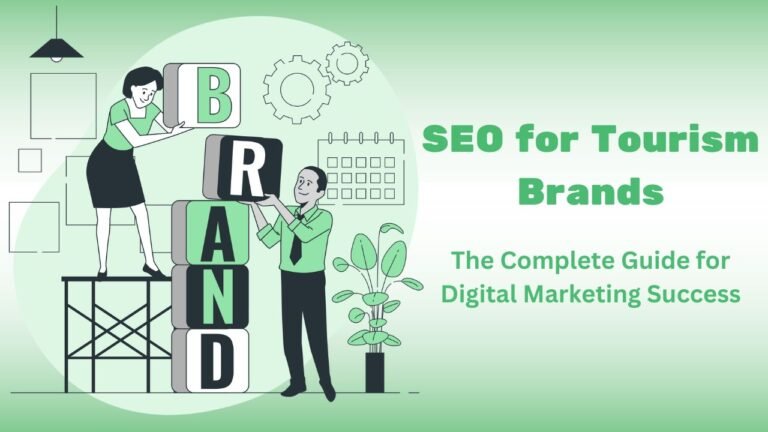
SEO for Tourism Brands: A Guide to Digital Marketing Success
Standing out in a crowded online market is a challenge travel and tourism businesses know all too well. But how do you create a strategy that outperforms competitors and converts traveller interest into consistent online success?
As the way people search shifts, making your brand and offerings the clear “entity” that search engines see and trust is key. That means crafting a unique strategy that helps you build a semantically rich ecosystem. And the key? Well, that’s where SEO for tourism brands steps in.
Whether you’re a travel brand owner or a digital marketer looking to expand your understanding of tourism brand SEO, this in-depth guide will get you on the right foot.
What Is SEO for Tourism Brands?
Tourism search engine optimisation (SEO) is the process of developing and implementing a strategy that provides your travel brand with the best potential to earn revenue. The primary goal of SEO is to improve your brand’s search engine rankings for relevant keywords, thus increasing your chances of landing organic traffic and leads.
By improving your website’s authority, semantic relevance (A.K.A. how referencable you are in your niche), and the overall user experience (UX), you can start to see some impressive results.
That said, travel SEO isn’t a one-size-fits-all digital marketing technique. Instead, you need to craft a unique strategy for each travel business, one that aligns with the brand’s underlying strategy and goals.
The Basics of Tourism Brand SEO
From improving your local search visibility to your technical SEO, here are the top 5 practices that business owners and marketers in the travel industry should look to use.
1. Rank for Local SEO with a Google Business Profile
If you are a local business, such as a hotel or tour operator, one of the most important tools in your arsenal is your Google Business Profile (GBP). Why? Because it legitimises your business in the eyes of Google, and it offers you another avenue to earn traffic via Maps and AI Mode results. Plus, it provides an excellent opportunity to gain customer feedback through reviews.
By linking this profile to a website, you create an authenticating connection between your GBP and your website, thus improving your local SEO.
If you’re still not convinced by how influential GBPs are, here are some stats:
- Hospitality companies get around 8K business profile views per month, the most of any industry on Google search.
- Verified business profiles average around 200 monthly clicks, showcasing their importance for brand exposure and lead generation.
- 48% of monthly business profile actions are website visits.
- Customers are 7 times more likely to trust a business with a complete GBP.
- 75% of the top-ranking pages have complete GBPs.
Statistics sourced from Search Endurance
Simply put, a complete and verified Google Business Profile doesn’t just improve search results; it serves as a key authority signal for an effective SEO strategy.
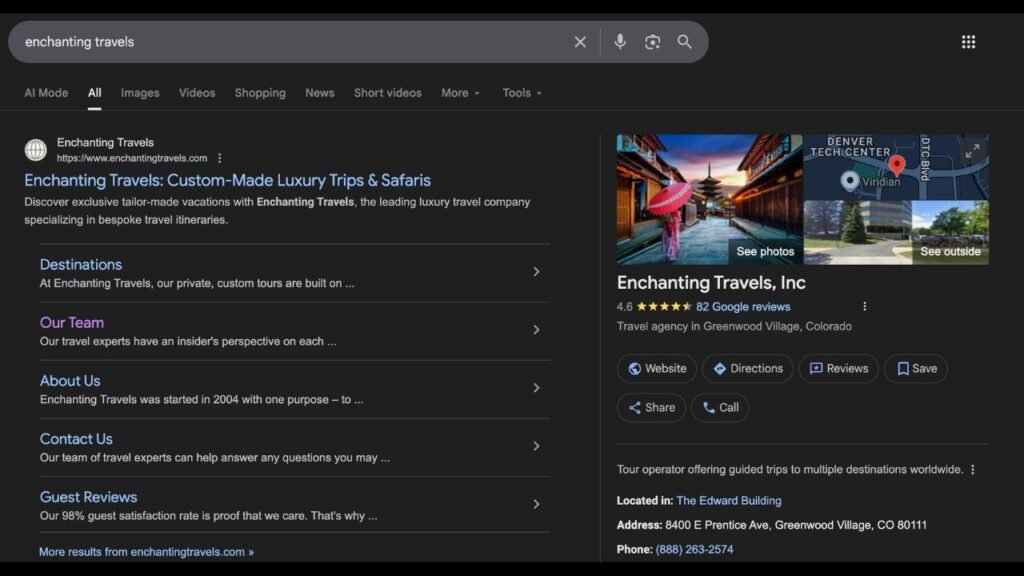
2. Improve On-Page SEO to Optimise Your Website for Mobile Devices
With a Google Business Profile all set up, you can now start focusing on your website’s on-page SEO. The most fundamental thing you need to be aware of is that Google is doing mobile-first indexing, so if your page isn’t loading correctly on mobile, it’s likely not to be indexed or ranked.
This is a make-or-break moment for many tourism websites, as it will impact the long-term success of your site. According to recent data, mobile device searches accounted for around 62% of total searches in 2025, underscoring the importance of making your website mobile-friendly.
Some of the key factors that impact how mobile-friendly your website is include:
- Responsive Design: Ensure your website design and layout adapt dynamically to the screen size.
- Page Speed: The bounce rate drastically increases the longer it takes your website to load.
- User Experience (UX): Make your website easy to use and visually clean to improve UX.
- Content-Rich Pages: Create pages with rich, beneficial content that is also referencable by GPT search tools.
- Structured Data: Use schema markup to help search engines and AI tools understand your content.
If you want to assess your website’s mobile-friendliness, visit the Core Web Vitals page in Google Search Console or run a test with PageSpeed Insights.

3. Use Keyword Research to Find and Target Long-Tail Keywords
Considering how competitive the tourism industry is, you need to find a way to get an edge over your competitors at every turn. This is where keyword research comes into play, as it not only helps expand your content marketing efforts but also ensures you target realistic keywords.
SEO is no longer just about ranking in the search engine results page; it’s about providing semantically relevant content that caters to search engines and AI search tools. A powerful topic-mining strategy allows you to cater to both search engines and AI engines, while expanding your topical clusters, expertise, and overall authority in your niche.
Some of our favourite topic mining techniques include:
- Direct Search: Searching directly on Google can often present missed topics and opportunities.
- Competitor Mine: Analyse your competitors’ ranking keywords to identify topic gaps and opportunities for improvement.
- Topic Mine: Finding long-tail keywords within a broad search term using tools such as Ahrefs and SemRush.
- GSC Topic Mine: Analysing keywords you already rank for to find missing content opportunities and how you can improve your website’s topical structure.
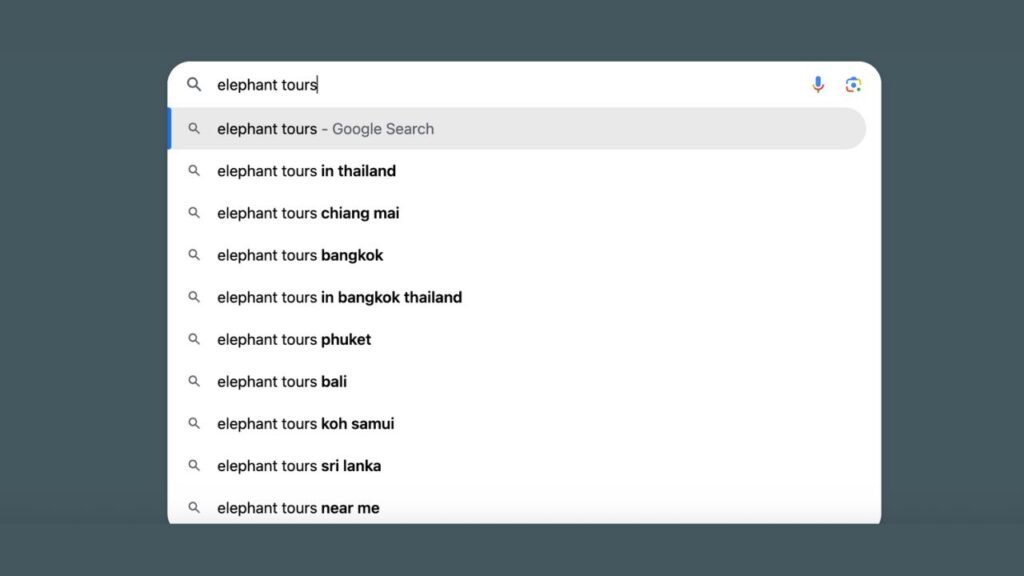
4. Look to Earn High-Quality Backlinks
Interest in link building is at an all-time high, and for good reason. Think of it this way: if your travel brand is regularly cited by large, authoritative websites within your niche, there’s a high chance you’ll be trusted.
While earning referrals naturally is ideal, sometimes your website needs a bit of help getting off the ground, and that is where link building comes in. An important note is that link building doesn’t always mean you need a link to be placed on an external website; simply mentioning your brand can do the trick, too.
Search engines and GPT tools are now considering the semantic relevance of your website, not just a blue link to it. As a matter of fact, Ahrefs recently found that brand web mentions offer the best correlation when being sourced by AI.
Some key factors to consider for link building include:
- Relevance: Make sure the target website is semantically relevant to your niche.
- Traffic Trajectory: If there’s evidence of significant traffic declines, it may be a low-quality link.
- Authority: While DR40+ links are usually good, some guest posting sites with this domain ranking aren’t good quality. Cross-reference their traffic to check quality.
- Sometimes less is more: Sometimes it’s better to earn one very high-quality, niche-relevant link than 100 low-quality ones.
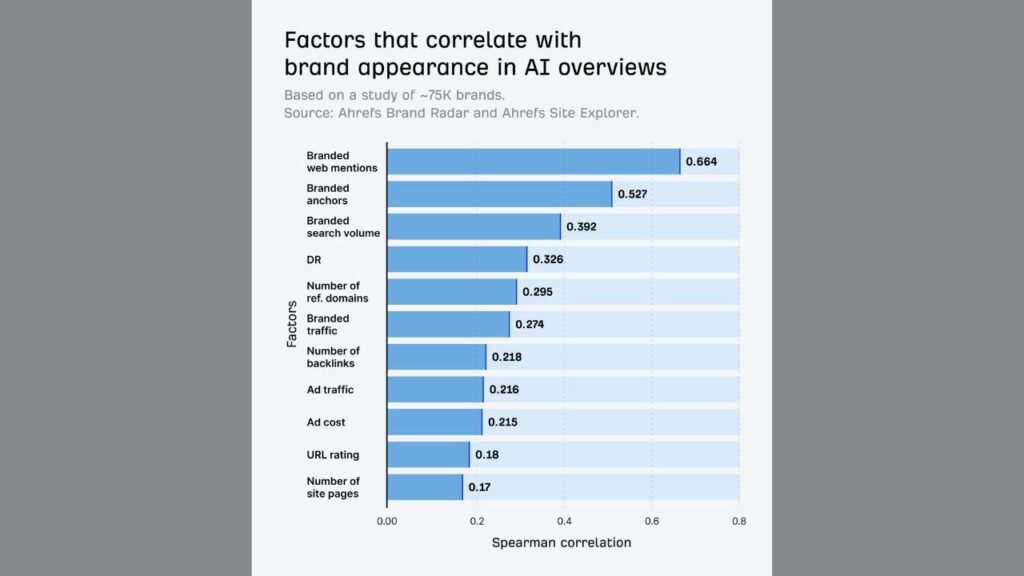
5. Track and Analyse Brand Performance to Find Opportunities for Improvement
Assessing your website’s performance is essential for consistent growth, especially for multi-lingual SEO brands targeting multiple locations and audiences. Analysis is also far more than just tracking search traffic; it entails a detailed assessment of all the aspects of your website.
Some of the key factors you should consider in a monthly analysis include:
- Search Rankings: Organic traffic is still one of the most consistent driving factors of sales, so assessing your website’s rankings on a monthly basis is crucial.
- Site Speed: Maintaining a positive user experience is crucial, so keeping your site as fast as possible is a top priority.
- AI Mentions and referrals: To check mentions in AI Overviews and AI Mode, you may need to use tools such as Ahrefs. For referrals from ChatGPT, Perplexity, and other AI tools, use GA4.
- Lead Sources: GA4 often helps you identify where leads have come from using the user source /medium
There are several other metrics you can analyse, but these are some of the most important for maintaining performance and encouraging growth.
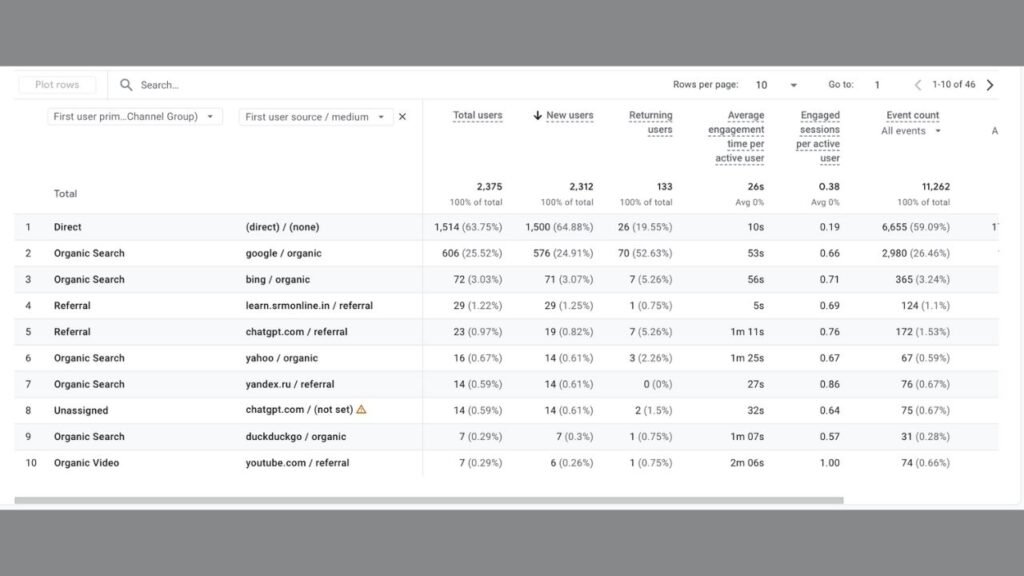
How to Do SEO for Tourism Websites Today
Each year, new strategies and factors emerge that influence what works and what doesn’t in SEO. Here’s a look at what is effective SEO today, and how you can adjust your brand’s strategy for success.
How AI Search Engines Are Changing Travel Brand SEO
The main shift we’re seeing in travel brand SEO is the shift away from focusing on keyword rankings. Now, it’s more important to be a trusted and cited source within conversation-based search engines.
But how do tourism brands make the most of this new strategy? The quick answer is to adopt semantic retrieval optimisation (SRO) into your marketing strategy. Simply put, this goes beyond just targeting keywords and means your content needs to focus on the context and user intent behind a search.
Fortunately, many of SEO’s previous practices are essential to the success of this strategy. Don’t worry, this next section is going to dive into the key components of SRO and how you can boost your brand’s website today.
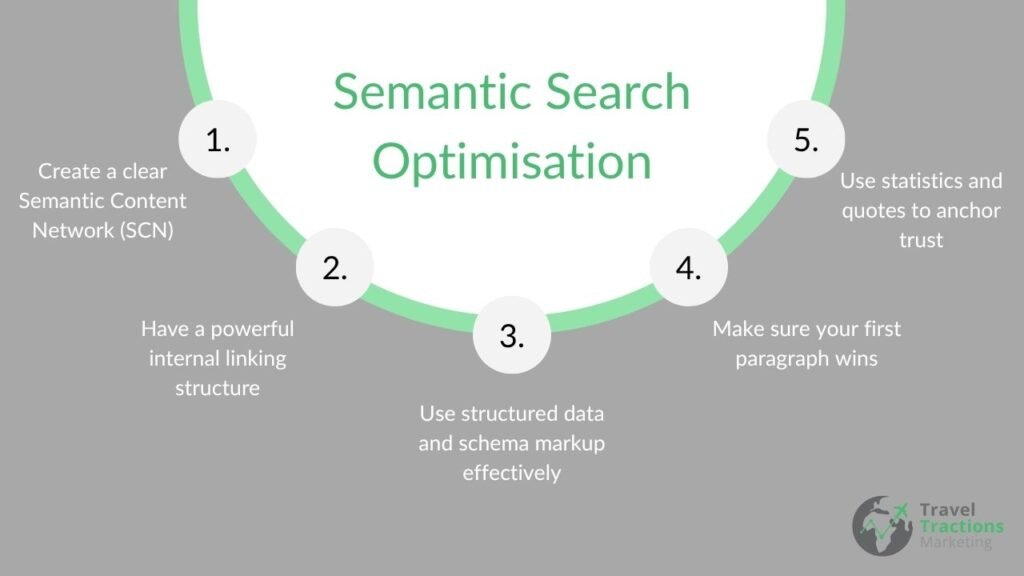
Best Practices for Tourism Brand SRO (Semantic Retrieval Optimisation)
Now, let’s look at the key factors of SRO that you can start implementing for consistent success in AI search tools.
1. Create a Clear Semantic Content Network (SCN)
Similar to your current content map or site structure, an SCN is essentially a content web. It differs from traditional content structure; the SCN aims to mirror AI’s process, reducing the amount of time it takes GPTs to retrieve information.
When put into practice, an SCN has a 3-step framework:
- Macro: Builds an entity hub using a broad topic or category that encompasses a range of related sub-topics or queries. I.e., Argentina Travel Agency.
- Seed: Mid-level branch topics, offering a more specific branch or sub-topic within the broader Macro category. I.e., Guided Tours of Argentina.
- Node: Specific fan-out queries. They are the most granular and sit underneath the Seed-level branch. I.e., Guided Argentina Tour Itinerary Checklist.
By addressing the various fan-out query variations, your content can better cover the topic’s scope. This helps reduce the retrieval gaps that conventional site structures often miss, helping you build stronger topical authority.
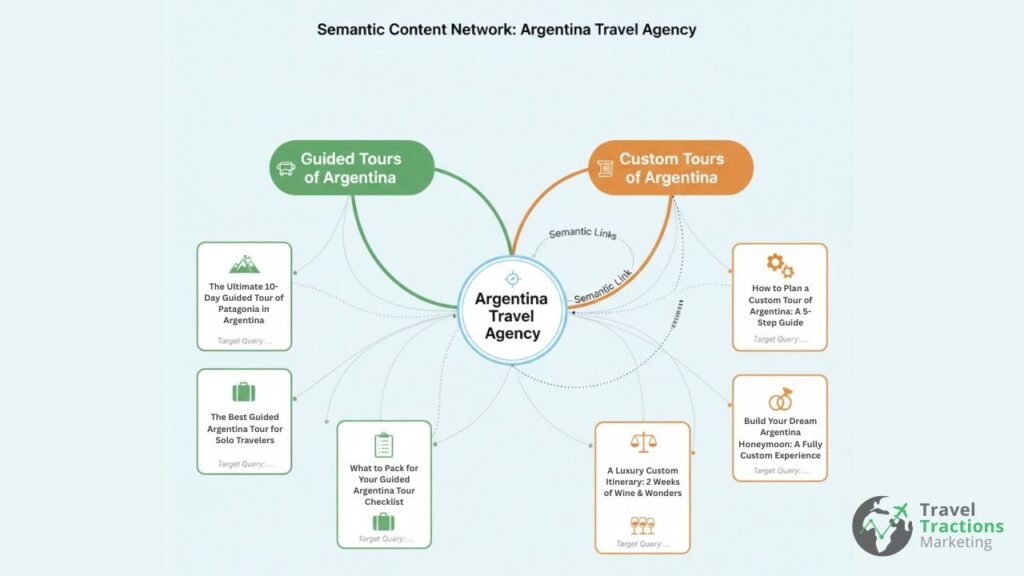
2. Have a Powerful Internal Linking Structure
Possibly one of the most essential parts of a strong SRO strategy is your internal linking structure. There are a couple of reasons why internal links are crucial to your strategy, including:
- Links reduce retrieval costs: They help you group related content together into cluster passages. This reduces the complexity required for AI systems to identify and retrieve the most relevant information.
- They compress semantic distance: Internal links go beyond just navigation, as they compress the semantic distance between related concepts and entities. This makes it easier for AI systems to understand the context and meaning of your content.
- Reduces Node drifting: Nodes that are not well-connected through internal links are more likely to drift away from the core topic. So, good internal linking means greater chances of being included in the final search results.
- Good linking makes retrieval bias stronger: Strong internal linking between the Macro, Seed, and Node levels of your content hierarchy reinforces the semantic relationship recognised by AI. This increases the chances of your content being included in search results.
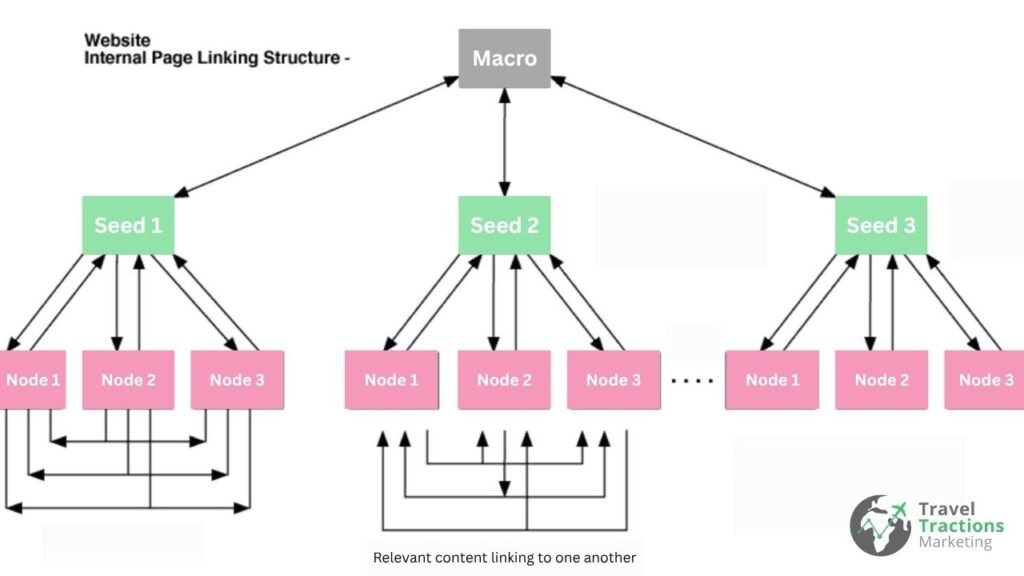
3. Use Structured Data and Schema Markup Effectively
Structured data and schema markup add machine-readable context to your website, strengthening AI’s confidence in your content’s meaning. It’s important to note that Schema doesn’t rank your content; it validates it.
Why is schema markup important for travel brands? Here are some of the top reasons:
- Provides an opportunity to earn rich snippets.
- It helps validate the relevance of your content.
- It enables you to build trust signals that show your brand as legitimate.
- It makes your content more skimmable and easier for AI systems to understand.
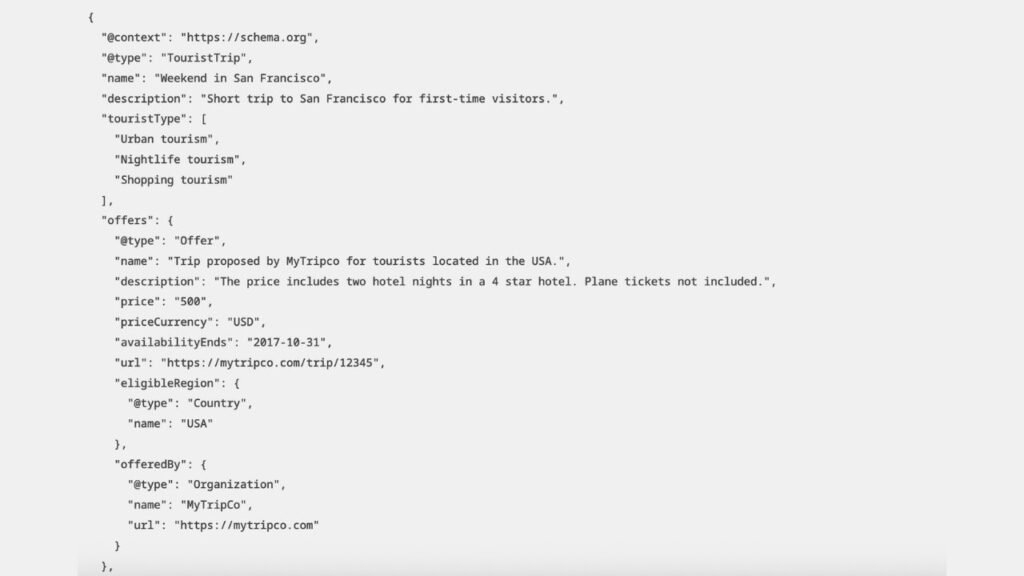
4. Make Sure Your First Paragraphs Win
The paragraph of your topic is usually the first section that people read; it’s also likely to be the first part of the page that AI systems skim through.
As such, it’s essential that your first 100 – 150 words anchor your entity salience. In other words, it answers the questions and frames what is to come later in enough detail that AI search engines can attribute value to your content.
You’ll want to answer direct questions early to increase the likelihood of your content being referenced by AI search results. Plus, having an engaging opening paragraph that answers the search intent is more likely to result in longer dwell times on your website from organic search users.
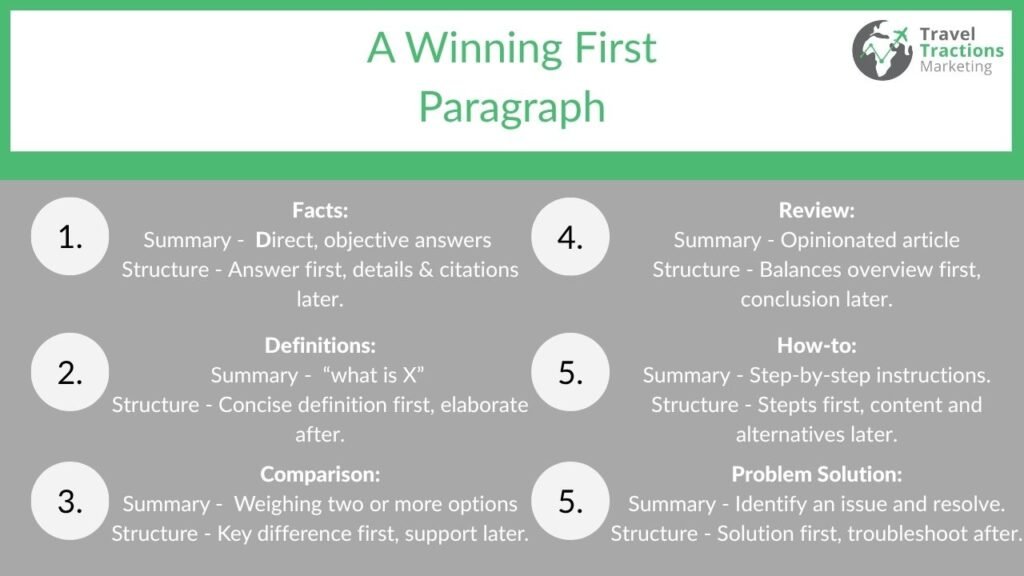
5. Use Statistics and Quotes to Anchor Trust
While internal linking is essential, external links to statistics and quotes can be just as effective. Referencing authoritative external sources for data and quotes from industry experts helps establish credibility.
Additionally, user-generated content, case studies, and citations reduce AI uncertainty, increasing the likelihood of being placed in search results. The more you factor external validation into your tourism SEO strategy, the better your chances of success.
Wrapping Up SEO for a Tourism Company
Just like that, you have a comprehensive introduction to tourism brand SEO. Hopefully, this will help you avoid some common tourism SEO mistakes and get your website on the right track.
If you still feel a bit in the dark, you’re never alone. Our expert SEO travel services can help shed light on the above techniques and turn strategy into success.






